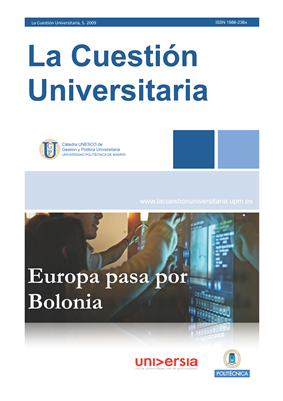La Educación, un hecho espacial: el “Campus Didáctico” como arquitectura para el Espacio Europeo de Educación Superior
Keywords:
Universidad, arquitectura y urbanismo, campus, calidad, educación superior, aprendizaje medioambiental, modalidades de aprendizaje, innovación, espacio, motivación, planificación campus, modelos universitarios, adaptación al EEES y plan director.Abstract
Nuestras Universidades se hallan inmersas en la compleja adaptación académica al Espacio Europeo de Educación Superior (EEES). Pero, ¿se están preparando los campus españoles para una metamorfosis de semejante envergadura? Esta ineludible cuestión no está siendo prioritaria para Administraciones o Universidades. En su descargo, no toda la responsabilidad es nacional: desde la Declaración de la Sorbona (1998), no hay escrito alguno de los organismos internacionales sobre el espacio físico, ni en su dimensión urbanística (relación con la ciudad), ni arquitectónica (el campus). Como respuesta urgente, se debe formular una propuesta global: el “campus didáctico”, una filosofía que podría cimentar el salto de calidad que alimenta el EEES. La Universidad es vanguardia intelectual, pero también debe ser paradigma arquitectónico, medioambiental y sostenible. Como respuesta idónea al EEES, el Campus Didáctico puede aplicarse en cuatro esferas: la escala de espacios didácticos: la relación con la ciudad; el campus; el edifico académico y el aula. La transformación de los campus ante el EEES obliga a investigar modalidades de aprendizaje alternativas a la clásica lección magistral. Y estos modernos formatos pedagógicos necesitan unos espacios “didácticos” ad hoc que los alberguen. La educación superior se enfrenta pues a un escenario esperanzador, pero que exige revolucionar sus modelos. Al final, todo acabará afectando al campus (imagen y cuerpo de la institución). Como esto no debe improvisarse, reclamo actuar en dos niveles: las Administraciones deben dictar sin demora recomendaciones para optimizar la arquitectura docente; y –con más urgencia aún–, las universidades tienen que planificar la reestructuración de sus sedes y edificios. Bolonia 2010 no es ni origen ni final del cambio necesario, pero sí un inmejorable pretexto para el salto de calidad de las Universidades.
Abstract
Our Universities are currently involved in the complex process of academic adaptation to the European Higher Education Area (EHEA). But, are the spanish campuses preparing themselves for a transcendental metamorphosis? This unavoidable issue is not yet a priority for Administrations or Universities. In their defence, not all the responsibility is national: since the Sorbonne Declaration (1998), there is no text at all from any international organization that refers to the physical space, nor in the urban dimension (relation to the city) or architectural (the campus). As an urgent solution, a global proposal must be formulated: the “educational campus”, a philosophy which could lay the foundation of the quality headaway which fosters the EHEA. The University is an intellectual avant-garde, but it must also become an architectural, environmental and sustainable paradigm. As the most suitable response to the EHEA, the “Educational Campus” can be implemented in four different spheres: the “Educational Spaces Scale”: relation with the city; the Campus; the academic building and the classroom. The transformation of the campuses in front of the EHEA forces a research about learning modalities which are alternative to the classic masterly lesson. And these modern pedagogical formats demand proper “educational” spaces which host them. Higher education is thus facing an encouraging scenario, but it demands a revolution in its models. In the end, everything will end up involving the campus (image and body of the institution). As this cannot be improvised, I claim for an urgent action in two levels: the Administrations must enact with no delay recommendations to optimize the academic Architecture; and –even more urgently–, universities have to plan the restructuration of their seats and buildings. Bologna 2010 is neither the origin nor the final stop of the needed change, but certainly it becomes an unbeatable pretext for the quality headaway of Universities.
Downloads
Downloads
Published
Issue
Section
License
1. Los autores conservan los derechos de autor y garantizan a la revista el derecho de una Licencia Creative Commons Atribución - Nocomercial 4.0 Internacional que permite a otros compartir el trabajo con un reconocimiento de la autoría y uso no comercial.
2. Los autores pueden establecer por separado acuerdos adicionales para la distribución no exclusiva de la versión de la obra publicada en la revista (por ejemplo, situarlo en un repositorio institucional o publicarlo en un libro).
Salvo indicación contraria, todos los contenidos de la edición electrónica se distribuyen bajo una licencia de uso y distribución “Creative Commons"




